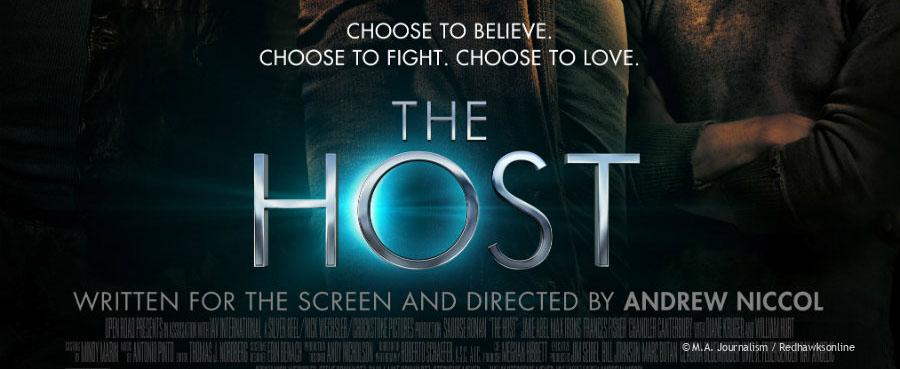“The book is always better than the movie.” How often do we hear this? After every book to movie adaptation, there are always those who will proclaim that the movie could never compare to the book. But is it true?
While the fact stands that often in these paper-to-film moves some literary elements are lost, usually because of time constraints, the movie can also bring in new visual effects that can cancel out these losses. In The Host, released in theatres March 29, director Andrew Niccol gives an example of a well done transformation from a lengthy novel, written by Stephanie Myers (Twilight series), to an exciting new film.
The general premise of The Host is aliens, invading body snatchers who latch onto human minds and take control. The aliens are only seen a few times, and they can best be described as ethereal, glowing insects. At the beginning of the movie, the aliens have almost complete control of our world, but we come to learn about human resistance that might prevent complete alien takeover.
The movie presents the worlds of the aliens versus that of the humans as clean versus dirty. The aliens all wear spotless white outfits, they work in modernistic offices with non-imaginative chrome themes, and drive, and fly, in reflective silver cars and helicopters. And because the aliens live in the humans minds, their eyes glow bright blue. Everything is spotlessly surreal.
In comparison, the humans are dirty and muddy, and often covered in blood. They live in caves out in the desert and everything about them conveys desperate life. This effect really helps to develop the movie as well as giving the viewers a clear way to differentiate between “good” and “evil.” And it is also an example of how the film production staff can create something for the film that is not as present in the book, but is still beautiful and works well.
The main character of The Host is a teenage girl, Melanie Stryder (Saoirse Ronan), who recently became inhabited by an alien named Wanderer, or Wanda. While Wanda is now in control of Melanie’s body, Melanie’s mind does not completely disappear. Because of this, a lot of the plot of the movie takes place in Wanda’s head as she and Melanie fight for control.
At the beginning of the film, I found the constant voice-overs by Melanie slightly obnoxious, but as the film progressed it was like the actress, Ronan, finally figured out how to do it, and Melanie began to deliver lines that caused uproarious laughter in the theater.
While Ronan was only so-so, I would recommend this film purely because of the performances of some of the other stars. In the role of the seeker, the intense alien cop trying to capture the Melanie/Wanda duo after they run to the resistance, Diane Kruger is unstoppable. She conveys the air of one about to lose their mind, and we journey with her as she does just that. Another fantastic performance came from William Hurt as the dirty cowboy looking leader of the resistance, Jeb Stryder. He’s tough and stern, but through his actions towards Wanda/Melanie and her innocent little brother Jamie we see he has a heart of gold. These actors helped to bridge the book to film gap and create something worth watching.
A key part of the plot is this weird love-triangle/square that develops. This complicated relationship is what drew Max Irons to the movie originally. When I got the chance to interview Irons, he told me, “I couldn’t think of any other film, or book with that problem…. It’s a nice thing for an actor to get to do.”
To sum up this affair in a couple of sentences: Melanie, before being inhabited by Wanda, was in a relationship with a boy named Jared (Irons). After she and Wanda find the resistance they also find Jared, who still loves Melanie, but wants to kill Wanda who lives in her head. Over the course of their time with the resistance Wanda falls in love with a human named Ian (Jake Abel), who loves her back. This causes problems as Melanie cannot stand Ian touching her, and she often screams at Wanda in her head when this happens, causing much laughter on the viewer’s part.
This could be a confusing and muddled mess, but thanks to a well written script by Andrew Niccol, and some great performances by Jake Abel as Ian, and Max Irons as Jared, it works.
The Host was a well thought out adaptation of Stephanie Myers’ greatest book. It makes the audience think about the end of the world, as well as the strength and state of the human mind. Thanks to the actors and actresses as well as superior directing and visual crews, the movie is at the same level as the book. It will captivate you on an emotional level with the “survival aspect”, which is what Irons told me he found most compelling about the film, and the artistry and sets will draw you in on a more superficial level.
Claiming “the book is always better than the movie” may often be true, but in this case I wouldn’t believe it. When I asked Abel what drew him originally to the film, he brought up the director, saying, “Andrew Niccol took the strongest points of each character and boiled them down.” This superb directing lets the stars shine in their roles. The movie is well done, amusing, and enjoyable.

